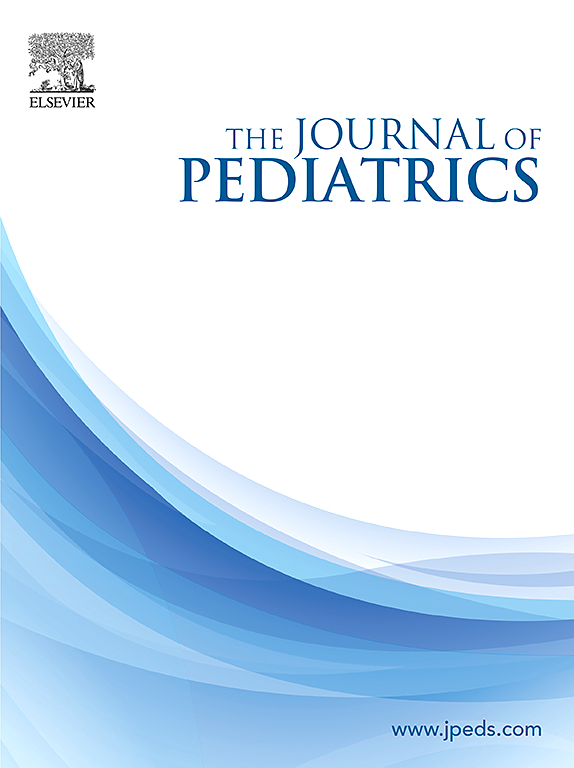错失的机会:单中心洞察产前心脏姑息治疗。
IF 3.5
2区 医学
Q1 PEDIATRICS
引用次数: 0
摘要
目的:了解我院重症先天性心脏病(CCHD)患者产前姑息治疗(PC)的使用率是否低于10%,尽管亚专科姑息治疗咨询在共同决策、沟通和家庭压力方面有所改善。研究设计:对2020年1月至2023年12月某三级中心产前CCHD诊断进行回顾性研究。收集患者的初始住院特征、PC的存在和时间、生存或死亡机制。早期PC被定义为发生在产前或死亡前30天以上。比较早期、晚期、无PC会诊患者的临床特征。结果:产前诊断出冠心病的506例。只有12% (n=61)进行了PC咨询,其中4人在产前进行了PC咨询。与晚期或未接受PC的患者相比,遗传诊断的患者早期PC咨询的发生率更高(61% [n=27] vs 35% [n=6] vs 26% [n=117])。鉴于亚专科PC在CCHD产前诊断中的应用不足,对高危患者实施常规PC会诊可提高该队列中PC的参与程度。本文章由计算机程序翻译,如有差异,请以英文原文为准。
Missed Opportunities: Single-Center Insights into Prenatal Cardiac Palliative Care
Objective
To determine whether prenatal palliative care (PC) utilization for patients with critical congenital heart disease (CCHD) at our institution is less than 10%, in spite of improvements in shared decision-making, communication, and family stress afforded by subspecialty PC consultation.
Study design
A retrospective study of prenatal CCHD diagnoses at a tertiary center from January 2020 to December 2023. Initial hospitalization characteristics, presence and timing of PC, and survival or mechanism of death were collected. Early PC was defined as occurring prenatally or more than 30 days prior to death. Clinical characteristics were compared between patients with early, late, or no PC consultation.
Results
CCHD was diagnosed prenatally in 506 patients. Only 12% (n = 61) had a PC consultation, with 4 performed prenatally. Compared with those who received late or no PC, early PC consultation occurred more frequently for patients with genetic diagnoses (61% [n = 27] vs 35% [n = 6] vs 26% [n = 117], P < .001) or noncardiac congenital anomalies (61% [n = 27] vs 29% [n = 5] vs 35% [n = 154], P < .001). Of patients undergoing the highest complexity neonatal surgeries, 18% (n = 41) had subspecialty PC consultation. Overall, 12% (n = 60) of these patients died.
Conclusions
Patients with CCHD experience significant morbidity and mortality. Given the underutilization of subspecialty PC upon prenatal diagnosis of CCHD, implementation of routine PC consultation for high-risk patients could enhance PC involvement in this cohort.
求助全文
通过发布文献求助,成功后即可免费获取论文全文。
去求助
来源期刊

Journal of Pediatrics
医学-小儿科
CiteScore
6.00
自引率
2.00%
发文量
696
审稿时长
31 days
期刊介绍:
The Journal of Pediatrics is an international peer-reviewed journal that advances pediatric research and serves as a practical guide for pediatricians who manage health and diagnose and treat disorders in infants, children, and adolescents. The Journal publishes original work based on standards of excellence and expert review. The Journal seeks to publish high quality original articles that are immediately applicable to practice (basic science, translational research, evidence-based medicine), brief clinical and laboratory case reports, medical progress, expert commentary, grand rounds, insightful editorials, “classic” physical examinations, and novel insights into clinical and academic pediatric medicine related to every aspect of child health. Published monthly since 1932, The Journal of Pediatrics continues to promote the latest developments in pediatric medicine, child health, policy, and advocacy.
Topics covered in The Journal of Pediatrics include, but are not limited to:
General Pediatrics
Pediatric Subspecialties
Adolescent Medicine
Allergy and Immunology
Cardiology
Critical Care Medicine
Developmental-Behavioral Medicine
Endocrinology
Gastroenterology
Hematology-Oncology
Infectious Diseases
Neonatal-Perinatal Medicine
Nephrology
Neurology
Emergency Medicine
Pulmonology
Rheumatology
Genetics
Ethics
Health Service Research
Pediatric Hospitalist Medicine.
 求助内容:
求助内容: 应助结果提醒方式:
应助结果提醒方式:


